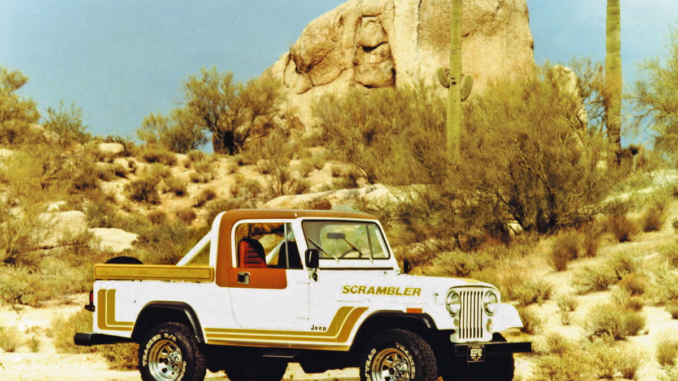
The 1981 Jeep CJ-8 Scrambler holds a special place in the history of American off-road vehicles. As a longer-wheelbase version of the iconic Jeep CJ-7, the Scrambler combined rugged capability with a unique utility design that appealed to off-road enthusiasts, farmers, and adventurers alike.
Though its production run was relatively short-lived, the CJ-8 left an indelible mark on Jeep culture and continues to be a sought-after classic vehicle.
The Jeep CJ-8 Scrambler was introduced in 1981 as a response to consumer demand for a more versatile version of the CJ-7. With roots tracing back to Jeep’s military vehicles, the Scrambler was part of the CJ (Civilian Jeep) series that began in 1945. The CJ-8 featured a longer wheelbase, extending the CJ-7’s 93.4 inches to 103 inches. This added length allowed for a pickup-style cargo area, making the CJ-8 a hybrid between a utility truck and a traditional Jeep.
Built under the American Motors Corporation (AMC) banner, the CJ-8 was designed to cater to a variety of uses, from off-road exploration to light-duty work applications. Despite its versatility, the CJ-8 struggled to gain significant traction in the market, partly due to competition from more established pickup trucks and SUVs. Production of the Scrambler ceased in 1986, but its legacy continues.

The CJ-8 Scrambler came with a range of engine options to suit different driving needs. Base models were equipped with AMC’s reliable 2.5-liter inline-four engine, which produced 82 horsepower. For those seeking more power, a 4.2-liter inline-six engine was available, delivering 112 horsepower and 210 lb-ft of torque. These engines were paired with either a four-speed manual transmission or an optional three-speed automatic transmission.
The CJ-8’s drivetrain included Jeep’s famous four-wheel-drive system, ensuring exceptional off-road performance. With a solid front and rear axle, the Scrambler provided excellent articulation and durability for tackling rough terrain. Its extended wheelbase offered improved stability compared to the CJ-7, though it came at the cost of a slightly reduced turning radius.
One of the most distinguishing features of the CJ-8 was its pickup-style bed, which set it apart from other models in the CJ lineup. The cargo area was available with either a hard or soft top, allowing owners to customize the vehicle for their specific needs. The Scrambler’s body-on-frame construction, combined with high ground clearance and sturdy suspension, made it ideal for off-road adventures.
The CJ-8 retained the classic Jeep aesthetic, with a boxy design, round headlights, and the iconic seven-slot grille. Buyers could choose from a variety of color options and decal packages, including the popular “Scrambler” graphics that adorned the sides of the vehicle. Inside, the CJ-8 offered a no-frills interior with basic instrumentation and durable materials designed to withstand rugged use.

AMC marketed the CJ-8 Scrambler as a versatile and rugged vehicle that could handle both work and play. Advertisements emphasized its dual-purpose nature, showcasing the vehicle’s off-road capabilities alongside its utility as a light-duty pickup. The marketing strategy highlighted the Scrambler’s appeal to outdoor enthusiasts, farmers, and small business owners.
Taglines like “The Fun Begins Where the Road Ends” and “America’s Most Versatile Vehicle” underscored the Scrambler’s adventurous spirit. Print ads often featured the CJ-8 navigating rocky trails, hauling equipment, or parked at a scenic campsite, reinforcing its image as a go-anywhere, do-anything vehicle.

Though the CJ-8 Scrambler never achieved the widespread fame of the Jeep CJ-5 or Wrangler, it made appearances in popular culture. The vehicle’s rugged charm and unique design made it a natural fit for roles in TV shows and movies depicting outdoor adventures or rural settings.
One notable pop culture reference is the Scrambler’s use in the 1980s TV series The Fall Guy, where it was driven by Colt Seavers, a stuntman and bounty hunter played by Lee Majors. The Scrambler’s role in the show helped solidify its status as a cool and capable off-road vehicle.
The CJ-8 Scrambler’s unique blend of style and capability attracted a variety of celebrity owners over the years. Actor Clint Eastwood, known for his rugged on-screen persona, reportedly owned a Scrambler, appreciating its utilitarian design and off-road prowess. Similarly, musician Jimmy Buffett was known to own a Scrambler, reflecting his laid-back, adventurous lifestyle.
Several features set the CJ-8 Scrambler apart from other vehicles of its era. The extended wheelbase and pickup bed made it one of the most versatile Jeeps ever produced, capable of handling tasks that other CJs could not. Additionally, the availability of both hard and soft tops, as well as a wide range of aftermarket accessories, allowed owners to customize their Scramblers to suit their needs.
The CJ-8’s relatively low production numbers—approximately 27,792 units were built between 1981 and 1986—have made it a highly collectible vehicle today. Restored Scramblers often command high prices at auctions, especially models with original equipment and unique options.
The Scrambler also paved the way for future Jeep models that blurred the lines between SUV and pickup, such as the modern Jeep Gladiator. Its legacy as a trailblazing hybrid vehicle continues to influence Jeep’s design philosophy and product lineup.
The 1981 Jeep CJ-8 Scrambler stands as a testament to Jeep’s ingenuity and willingness to push the boundaries of vehicle design. Though it was not a commercial success during its production years, the Scrambler has become an icon among Jeep enthusiasts and a symbol of rugged versatility. From its distinctive design to its enduring appeal, the CJ-8 remains a beloved chapter in Jeep’s storied history.
Everyday your story is being told by someone. Who is telling your story? Who are you telling your story to?
Email your sustainable story ideas, professional press releases or petro-powered podcast submissions to thecontentcreationstudios(AT)gmail(DOT)com.
#thecrudelife promotes a culture of inclusion and respect through interviews, content creation, live events and partnerships that educate, enrich, and empower people to create a positive social environment for all, regardless of age, race, religion, sexual orientation, or physical or intellectual ability.



